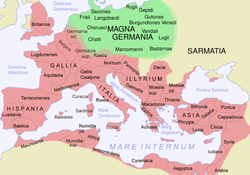Agri Decumates




The Agri Decumates or Decumates Agri ("Decumatian Fields") were a region of the
The meaning of Decumates is lost and has been the subject of much contention. According to the English Classicist
According to Tacitus, the region was originally populated by the Celtic tribe of the Helvetii, but soon Germanic and Gaulish settlers arrived. Tacitus writes that:
I should not reckon among the Germanic tribes the cultivators of the tithe-lands [agri decimates], although they are settled on the further side of the Rhine and Danube. Reckless adventurers from Gaul, emboldened by want, occupied this land of questionable ownership. After a while, our frontier having been advanced, and our military positions pushed forward, it was regarded as a remote nook of our empire and a part of a Roman province.[2]
Under the
The larger Roman settlements were Sumolecenna (
Romans controlled the Agri Decumates region until the mid-3rd century, when the emperor Gallienus (259–260) evacuated it before the invading Alemanni and the secession of much of the Western Roman Empire under the "usurper and ruler" Postumus.[6]
The Emperor
J. G. F. Hind has suggested.
Notes
- ^ a b M. Grant, A Guide to the Ancient World, p. 17
- ^ a b c Tac. Ger. 29.
- ^ Ptolemy's Geography — Book II, Chapter 10
- ^ J. G. F. Hind, "Whatever Happened to the 'Agri Decumates'?" p. 188, where he links it to the Old Irish dechmad.
- ^ Smith, William (1854), Dictionary of Greek and Roman Geography
- ^ L. de Blois, The Policy of the Emperor Gallienus, p. 5, 250
- ^ D. Geuenich, Geschichte der Alemannen, p. 23
- ^ J. G. F. Hind, "Whatever Happened to the 'Agri Decumates'?", p. 189ff.
Bibliography
- Grant, Michael (1986), A Guide to the Ancient World: A Dictionary of Classical Place Names, New York: H. W. Wilson, ISBN 0-7607-4134-4
- Strayer, Joseph R. (1982), Dictionary of the Middle Ages, vol. 1, New York: Scribner, ISBN 0-684-18276-9
- Jankuhn, Herbert; Beck, Heinrich, eds. (1984), Reallexikon der germanischen Altertumskunde, vol. 5, Berlin: de Gruyter, ISBN 3-11-009635-8
- Syme, Ronald, ed. (1958), Tacitus, vol. 1, Oxford: Clarendon Press
